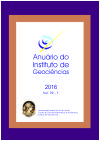Comparison of Microphysical Properties of Clouds in Two Regions Tropical With Distinct Ecosystems Using Satellite Data from CloudSat
DOI:
https://doi.org/10.11137/2016_1_111_126Keywords:
Cloud microphysics, Aerosol, CloudSatAbstract
The approach used in this work's methodology looks to represent the average microphysical structure of different types of clouds formed in two different ecosystems. The selected regions were located in the Midwest of Brazil (coordinates: 12-18 ° S and 46-58 ° W) and the South Atlantic Ocean (coordinates: 12-25 ° S and 9-30 ° W). In order to accomplish the proposed goal, data from CloudSat satellite from a period of approximately five years are used (from June 2006 to April 2011). The results show that there is little variation in microphysical structure between continental and maritime clouds in the studied regions. The mean droplet (ice particle) effective radius obtained in all the cloud types analyzed was 12.4 μm (71.9 μm) for maritime clouds and 11.0 μm (72.9 μm) for continental clouds. Particle size distribution (concentration as a function of size) was the most efficient parameter to distinguish cloud types, making it possible to identify particularities of each type. The results showed that even in the period with the highest concentration of aerosols observed in the Central-West region of Brazil (spring), there is a significant difference in the cloud particle size distribution in the regions studied. These results indicate that other external agents (besides the total concentration of aerosol integrated in the atmospheric column) are acting more significantly to modulate the particles distribution within the clouds in the Central-W est region.Downloads
Download data is not yet available.
Downloads
Published
2017-02-15
How to Cite
Justo, L. A. J. and França, J. R. de A. (2017) “Comparison of Microphysical Properties of Clouds in Two Regions Tropical With Distinct Ecosystems Using Satellite Data from CloudSat”, Anuário do Instituto de Geociências. Rio de Janeiro, BR, 39(1), pp. 111–126. doi: 10.11137/2016_1_111_126.
Issue
Section
Article
License
This journal is licensed under a Creative Commons — Attribution 4.0 International — CC BY 4.0, which permits use, distribution and reproduction in any medium, provided the original work is properly cited.















